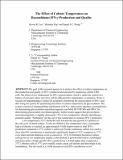| dc.description.abstract | The goal of this research project is to analyze the effect of culture temperature on the production and quality of IFN-γ produced and secreted by suspension culture CHO cells.The effect of low temperature on IFN-γ glycosylation, which is under the control of a battery of enzymes whose activities will be influenced by temperature, is unknown. Work is focused on implementing a system for accurately monitoring the glycosylation of IFN-γ and then using the system for quantifying the effect of culture temperature on glycosylation. The system consists of immunoaffinity purification of IFN-γ , followed by capillary electrophoresis for determining glycosylation macroheterogeneity and MALDI-TOF MS and HPLC for determining glycosylation microheterogeneity. Initial results suggest that glycosylation macroheterogeneity is slightly decreased (~5%) at low temperature, thereby identifying a potential quality “bottleneck” for the use of low temperature to increase IFN-γ production.
Low temperature (32°C) shifts the cells towards the non-growth, G1 portion of the cell cycle. In batch culture, if cells are shifted to low temperature once a reasonably high cell density is reached, an approximately 4-fold improvement in total IFN-γ production compared to 37°C culture is achieved. Pseudo-continuous culture was used to show that IFN-γ production is statistically significantly higher at 32°C compared to 37°C even when nutrient depletion is not a concern (p < 0.5). In fed-batch bioreactor culture, cells grown at low temperature display a short period of growth followed by a prolonged stationary phase of high specific IFN-γ productivity (~4-fold higher than compared to 37°C) whereas cells at 37°C grow rapidly, reach a peak cell density and then begin to die immediately. The net result is a 2-fold increase in total IFN-γ production at low temperature. Real-time RT-PCR was used to show that the amount of IFN-γ mRNA present during the 32°C stationary production phase is approximately 4-fold higher than the amount present during the exponential growth phase of the 37°C culture.
To further explore the effect of low temperature on cell RNA levels, total RNA per cell was quantified during the course of batch cultures at 32°C and 37°C. Total RNA levels were found to be approximately 50% higher at 32°C than 37°C. The kinetics of the low temperature RNA concentration profile was modeled to obtain transcription (Ks) and degradation (Kd) rate constants and these were found to be consistent with literature values. This finding suggests that temperature shift may offer a novel approach for measuring RNA kinetic parameters in any cell system that can tolerate mild temperature changes. | en |
